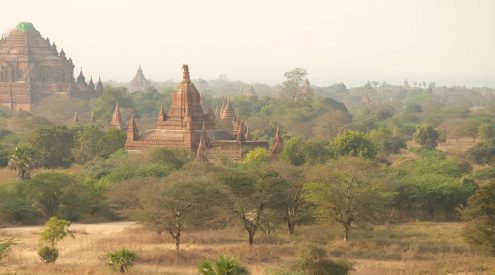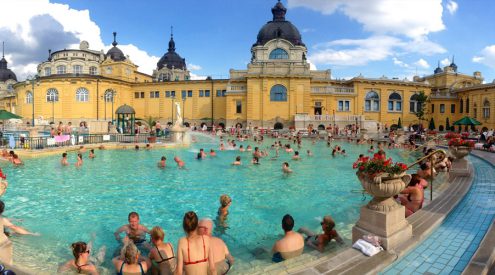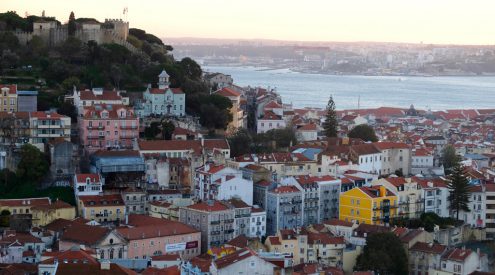Bhutan, the last secret this world holds, is an unspoilt kingdom nestled in the eastern part of the Himalayas where culture and traditional lifestyle is still intact. What would it be like to visit a country where the gross GDP is measured by the happiness of its citizens?
I could hardly take in the beauty of the scenery from the plane porthole. I had seen many a picture of Mount Everest and its many peaks but nothing could have prepared me for this. If only a camera snap-shot could give justice. DRUK-AIR (Royal Bhutan Airlines) is the national carrier of the Royal Government of Bhutan and the only airline officially allowed to fly into Bhutan. When the announcement came from the cockpit to prepare for landing I could swear that the wings of the plane were going to touch the mountain sides as we descended into the Valley of Paro. I soon realized that it was the least of my worries as Orson Welles puts it so cunningly ” There are only two emotions in a plane boredom and terror” and it was the latter that filled my being when I saw what must be the shortest airstrip in the world. I braced myself for one of those “have you been shot down or fallen from the sky” landings but the jet touched down on the runway with the same grace and poise as we were met by and reflected in our agent from Peaceful Tours and Treks.
The Bhutanese people have largely lived a life of isolation from the world. The country only began to open up to outsiders in the 1970s. The air of Buddhist spirituality is evident, where the spinning of prayer wheels, the murmur of mantras and the glow of butter lamps in the houses are still important features of everyday life.
Monasteries, temples and religious monuments are dotted across the landscape, bearing witness to the importance of Buddhism, while red-robed monks are everywhere, mingling freely in towns, villages and markets. Most of the population continue to live in small, isolated farms and hamlets, surrounded by terraced fields of rice and cereal crops. The general approach to life is more relaxed. It is rare to see Bhutanese nationals in Western dress, men wear a knee length, hand-woven robe called the “kho”¦ and women wear an ankle length garment called the “kira”¦, which is made from fine, hand-woven fabric, for which Bhutan is well known.
A trip to Bhutan normally begins and ends in Paro. As we disembarked from our flight the first thing that struck us was the very distinctive architectural style reflected in all of the buildings, unlike anything we had seen before. Willow trees line the main road from the airport to Paro town and a pleasant peace fills the air and from the high places bright coloured flags flutter in the wind sending out their prayers on windhorses. Paro is host to the national museum and the oldest dzongs in Bhutan.
Tiger’s Nest, a few kilometres outside of Paro town, is an absolute must for all visitors. The hike on foot to the monastery takes about 3 hours and for the faint hearted not-so-fit souls a pony trek of approximately 2 hours is available. We had done both and in retrospect decided that hiking was a far more safe option as the ponies had a flair for trotting close to the mountain edges and it would make the fall so much further. It is said the Guru Rinpoche arrived in Paro Valley more than a millennium ago on the back of a legendary tigress. He meditated in a cave for 3 months and a monastery was later built called Tigers nest or Taktshang Lhakang. Arriving at the top we were welcomed by smiling staff of the Taksthang restaurant and a very welcome cup of tea offered to us.The view from the restaurant is awe inspiring and to top it all a traditional lunch is also served before hikers start making their way down hill. I often had to pinch myself just to make sure that I wasn’t dreaming but that all of this was for real!
Planning a trip to Bhutan
Available tours
Bhutan has 20 districts open to tourists, all of them worth a visit. Tours and treks are custom made to the visitors requirements but the following options are available:
Four- to fourteen-day tours
These cover the major sites of interest as well as visits to weaving, handicraft and paper emporiums. Archery tournaments are also a common sight and for the golf player a 9 hole golf course is located in Thimpu the capital city.
Trekking
For the more adventurous trekking options are available ranging from moderate to difficult. Druk path trek is a 6 day trek reaching a maximum altitude of 4210m, other options include Jumolhari trek, Laya and Gasa trek, Dagala Lakes trek and many more.
For more information visit www.bhutanpeacefultour.com or email [email protected].
Need to know
Visitors to Bhutan must book through a registered tour operator in Bhutan. The tourist authority in Bhutan sets a minimum tariff per day, the rate is the same for cultural tours or treks. All guests stay in Government approved hotels, guesthouses and lodges.
How to get to Bhutan
Drukair is the flagship airline from Bhutan and the only one that flies to Bhutan. It departs from Bangladesh, Nepal, India, Thailand, New Delhi, Calcutta and Guwahati in India. Flights are booked by the tour operator in Bhutan. It is well worth to have a few days stopover in one of the countries to maximize your time and costs for travelling to Bhutan.
Visas
All visitors require a visa and this is arranged by the registered tour operator in Bhutan. The cost is US$ 20.
When to go
Year-round travel although the rainy season starts in May until September, best time would be between August and May.
Bhutan highlights
• Tiger’s Nest – Paro
• Archery tournaments usually held at Losar (Bhutanese new year)
• Festivals, many taking place between September and December.
• Pelela pass and Trongsa Valley
• Punakha where the Pho Chhu and Mo Chuu rivers come together
• Bhumtang, the photographers heaven, home to several sacred Bhudist shrines.
• Tashiyangtse known for its skilled wood craftsmen.
Bhutan facts
Form of government: Constitutional monarchy
Area : (sq. Km) 47,000, land-locked.
Population: 708 000
Capital: Thimphu
Currency : Ngultrum at par with Indian Rupees
Languages : Dzongkha (national), Sarchopkha , Others including Nepali & English
Literacy rate : 47%

















